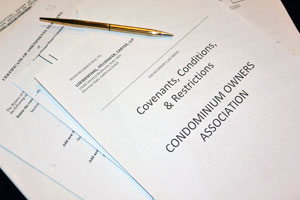LHC Newsletter, Vol. 8, No. 5
“Association Enforcement Options: Where Do We Go From Here?”
By: David A. Loewenthal, Esq.
In the ever combative world of homeowner associations, Boards of Directors must often decide how to deal with a member who is violating the Association’s governing documents or creating issues that are negatively impacting the Association. Often times, Boards simply think that the right solution is to file a lawsuit against the violating member, assuming that the Court will always support the decision of a Board of Directors against the owner. Unfortunately, not only is this assumption incorrect, but in many cases the filing of a lawsuit should be the Association’s last resort, not the first.
Other than those instances where a member’s action may be creating imminent threat of or actual harm or damage to persons or property, or if the conduct of the member is not immediately stopped that it may potentially prejudice the Association from pursuing the member in the future, Associations generally should take measured steps in attempting to obtain compliance. Usually this is in the form of ratcheting up the pressure, i.e. starting with a simple warning letter to hearings, fines, possible Internal Dispute Resolution, Alternative Dispute Resolution and, if all else fails, the actual filing of a lawsuit.
The following is a general overview and outline of the steps that an Association may take against a violating member. Again, one size does not fit all and in each instance where there is a violating member, the Board needs to carefully, rationally and reasonably evaluate the issues, costs and goals of the Association in making a decision.
In many instances, counsel should be brought in early to help direct a Board and give them proper guidance. This is especially true in those instances where a Board simply feels that filing a lawsuit should be the first action. In those instances, counsel can help guide a Board as to the reality of litigation, costs and likelihood of success.
I. Warning Letters, Hearing and Fines:
Generally, in the case of a member violating the governing documents, an Association should start by issuing a warning letter advising the member as to the violation, citing the provisions of the governing documents and/or statutes and requesting that the member immediately stop the violating action. This is generally an appropriate first step, other than in those instances where there may be emergency situation or involving imminent threat to persons or property or failure to act could create prejudice to the Association’s interest. In the event that the conduct does not stop after the warning letter then, the next step would generally be to schedule a hearing for purposes of considering imposing a fine or taking other disciplinary action.
Pursuant to Civil Code section 5855 entitled “Notice of Hearing/Notice of Decision” “when the Board is to meet to consider or impose discipline upon a member, or to impose a monetary charge as a means of reimbursing the Association for costs incurred by the Association and the repair of damage to common area and facilities caused by a member or the member’s guest or tenant, the Board shall notify the member in writing by either personal delivery or individual delivery pursuant to section 4040, at least ten (10) days prior to the meeting; (B) the notification shall contain, at a minimum, the date, time and place of the meeting, the nature of the alleged violation for which a member may be disciplined or the nature of the damage to the common area and facilities for which a monetary charge may be imposed, and a statement that the member has a right to attend and may address the Board at the meeting. The Board shall meet in Executive Session if requested by the member; (C) if the Board imposes discipline on member or imposes a monetary charge on the member for damage to the common area and facilities, the Board shall provide the member written notification of the decision, by either personal delivery or individual delivery pursuant to section 4040 within fifteen (15) days following the action; (D) a disciplinary action or the imposition of a monetary charge for damage to the common area shall not be effective against the member unless the Board fulfills the requirements of this section.”
As such, the key element is that the member is given proper notice of the hearing including the date, time and place of the meeting, and that the member has the right to attend for the purposes of addressing the Board of Directors.
Generally, the Board should only proceed forward with issuing a warning letter and, possibly proceeding forward with a hearing, if it has performed a reasonable investigation to determine the validity of the complaint against the accused violating member. This includes considering any written complaints that have been presented to the Board of Directors and/or the management company regarding the owner by other members; any violations personally witnessed by members of the Board of Directors or the community association manager; or if the violation can be independently confirmed through outside sources such as a police report, report from animal control, building department, etc.
If the Board does proceed forward with conducting a hearing then, the accused member has the right to present to the Board their own information and challenge the allegations. The Board must decide whether or not the information presented as to the member justifies taking further action, such as issuing a fine.
Ultimately, if an association wishes to collect on a fine, they may be forced to file a lawsuit. In such a case, the violating member would be entitled to perform discovery to obtain the information, evidence, etc. that the Board relied upon in issuing the fine. As such, unless the Board reasonably opines that it can support its decision regarding issuing a fine or taking other disciplinary action, it should not so proceed.
In order for the Board to issue fines against a member, there must be a published fine policy that is distributed annually to the membership. If there is a continuing fine, i.e. the violation does not stop, then, an Association can issue a continuing fine until such time as the violating member corrects their conduct or violation. Examples include, daily architectural violation until the violation is remedied; a member who parks daily in guest parking in violation of governing documents; a member who violates pet restrictions, etc. If a daily fine is going to be issued then, during the hearing, it should be made clear to the owner that if the violation is not cured that there will be an ongoing daily, weekly or monthly fine, until the issue is remedied, without a further or subsequent hearing.
With respect to suspension of privileges arising from rule violations, it must be identified in the Association’s published policy. An Association may not suspend privileges that would preclude an owner from accessing their unit, prevent them from being able to attend Board meetings or would cut off utilities. Such suspension of privileges must be limited in time and should be reasonably related to the violation.
Finally, it is important for an Association to understand that fines need to be reasonable and designed to obtain compliance. Fines should not be construed as “money makers” for an Association or a method of supplementing the Association’s financial resources. Fines that are construed to be unreasonable by a Court will likely be disallowed.
II. INTERNAL DISPUTE RESOLUTION (IDR)
Associations must have an IDR process designed to provide an informal method of resolving disputes between the Association and its membership.
Pursuant to Civil Code section 5910 entitled “Minimum Requirements for Internal Dispute Resolution”, the Association must have a “fair, reasonable and expeditious dispute resolution procedure.” Generally, this includes:
Either party can invoke the IDR procedure by requesting it in writing;
- The procedure should have prompt deadlines with a maximum time for the Association to act on the request.
- If IDR is requested by a member, an Association must participate; however, if IDR is requested by the Association, a member is not obligated to participate.
- If the parties enter into a written agreement, unless it violates the governing documents or law, the agreement is judicially enforceable.
- The IDR procedure must provide a means by which the member and Association may explain their respective positions. The member as well as the Association have the right to be assisted by an attorney or another person in explaining their position at their own cost.
- A member of the Association shall not be charged a fee to participate in the process.
It should be noted that if an Association does not adopt an IDR policy as set forth in Civil Code section 5910, then, pursuant to Civil Code section 5915, the statutory default entitled “Default Meet and Confer Procedure” will apply.
It is important to note that as of January 1, 2015, Association members are now allowed to bring an attorney or other person with them to an IDR meeting along with a Board member. See Civil Code sections 5910(b) and 5915(b)(4).
Unfortunately, a member is not obligated to notify the Board in advance of the members intent to bring an attorney or other person with them to IDR. As such, an IDR meeting could be scheduled, a Board member(s) could attend, along with the member who has brought an attorney with him. In such a case, Board member(s) in attendance should not proceed forward with the IDR meeting and advise the owner that it will have to be rescheduled to a date and time when counsel for the Association may also be in attendance.
III. ALTERNATIVE DISPUTE RESOLUTION (ADR)
Civil Code section 5925 defines Alternative Dispute Resolution (ADR) as follows: “(A) mediation, arbitration, conciliation, or other non-judicial procedure that involves a neutral third party in the decision making process. The form of Alternative Dispute Resolution chosen pursuant to this Article may be binding or non-binding, with a voluntary consent of the parties.”
In many circumstances, an Association or member may not proceed forward with filing an enforcement action in the Superior Court without first offering ADR.
Specifically, Civil Code section 5930 is entitled “ADR Prerequisite to Litigation” and states as follows: “(A) an Association or a member may not file an enforcement action in the Superior Court unless the parties have endeavored to submit their dispute to Alternative Dispute Resolution pursuant to this Article. (B) this section applies only to an enforcement action that is solely for declaratory, injunctive, or a writ relief, or for that relief in conjunction with a claim for monetary damages not in excess of the jurisdictional limits stated in section 116.220 and 116.221 of the Code of Civil Procedure. (C) this section does not apply to small claims action. (D) Except as provided by law, the exception does not apply to an assessment dispute.”
A party’s refusal to participate in ADR, where ADR is required under the code, allows the Court, in a lawsuit, to consider that refusal to participate in the awarding of attorneys fees. As such, a party could be the prevailing party in a lawsuit and generally be entitled to recover reasonable attorneys fees and costs; however, if that party had unreasonably refused to participate in ADR, the Court could decide not to award part or all of the attorneys fees to them. As such, it is generally recommended that if there is even a possibility that ADR applies to the situation an Association should accept a demand for mediation. Again, this would preserve attorneys fees and potentially provide an opportunity to resolve the case without proceeding forward into litigation.
Civil Code section 5935 is entitled “Request for Resolution” and sets forth the method for requesting ADR. The request should include a brief description of the dispute between the parties; a request for ADR; a statement that the party receiving the request has thirty (30) days to accept ADR otherwise it will be deemed rejected; and if the Association is making the request, they must provide a copy of the relevant Civil Code section pertaining to ADR with the request. ADR can be in the form of either mediation or arbitration (binding or non-binding).
Mediation is a process where the parties (Association and member), and counsel, retain the services of a third party neutral (either an attorney who has experience in Homeowners Association matters or a retired judged) for the purposes of listening to the parties, evaluating the issues and attempting to have the parties resolve the matter. A mediator has no enforcement power nor can they issue orders. However, if the parties execute a settlement agreement, that agreement is enforceable.
Alternatively, Arbitration is more akin to a formal lawsuit wherein a third party arbitrator, who can be an attorney or a retired judge, hears evidence and makes a ruling. In a non-binding arbitration, either party can reject the arbitration award and thus proceed forward with a lawsuit. In a binding arbitration, the arbitrator’s findings are in fact binding upon the parties.
Generally we view non-binding arbitration as largely a waste of time and money since the party that loses almost always will de novo the result and thus not be bound.
Generally, mediation is the preferred method of ADR.
IV. LITIGATION
Litigation (filing a Superior Court lawsuit) should not ever be entered into lightly and a Board should never believe that a case is a slam dunk, a no brainer, or piece of cake. Litigation is time consuming, expensive and the results are not guaranteed. Thus, a Board must seriously consider and evaluate proceeding into litigation and avoid the desire to “teach the member a lesson” who they believe has violated the governing documents or has thumbed their nose at the Board.
As referenced above, the Association’s general counsel should be consulted about the pros and cons of litigation before going down that path. The Association should also have the financial resources upfront to engage in litigation. All too often an Association has no concept of the costs associated with a lawsuit. The attorney may simply assume that the Association has the financial wherewithal to fund litigation. Associations should not commence a lawsuit if there is a legitimate risk of being in the middle of a lawsuit and determining that the Association is now out of money. Thus, the Association should make sure that they have the proper “war chest” to fund the litigation or a special assessment should be passed up front in order to fund the litigation.
The Board should also make sure that they have all of their ducks in a row before proceeding forward with litigation. Specifically, make sure that the Board has properly documented the issues that they are seeking to enforce against the member; determine that this is not a matter of selective enforcement against this particular member versus others; ensure that the Board objectively investigated and evaluated the matter and are not in any type of conflict of interest in proceeding forward (as an example a Board member pushing for a lawsuit against a member for noise violations simply because that Board member lives next door to the alleged violating member), etc.
When confronted with an Association issue, a Board needs to properly investigate the matter. If a Board’s action or inaction is ultimately challenged, how the matter was investigated is important in determining if the Board acted reasonably and in good faith in coming to a decision. A board should neither blindly accept nor reject issues presented to them. Boards need to make reasonable investigations into the issues and then decide about whether to proceed forward with litigation.
Remember, an Association has the right to file an action to enforce the governing documents, as well as for issues of damage to the common area or the separate property that the Association is obligated to maintain, repair, replace or restore, as well as construction defect matters. However, Boards are not automatically obligated to file a lawsuit to enforce their governing documents. This is an important distinction for Boards to understand. Specifically, an Association’s Board can weigh the cost of litigation, the potential benefit of the lawsuit versus the risk of losing and the costs associated therein. For example, but without limitation, should an Association potentially spend $100,000 to litigate a claim for damage to the common area possibly caused by a member wherein the repair cost is $5,000. Litigation often comes down to a cost benefit analysis and the key for the Board is being able to show that they reasonably evaluated and investigated the issues and then made a knowledgeable decision based upon the facts and circumstances surrounding the matter.


